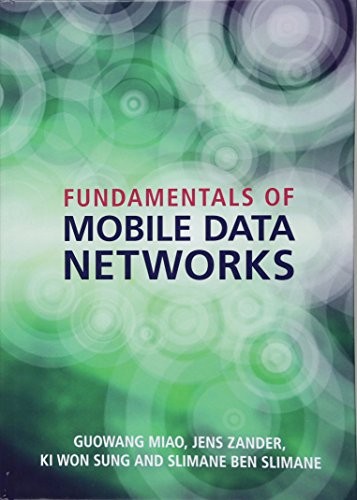Unlocking the Potential of Mobile Data Networks: Strategic Insights for the Modern Professional
In “Fundamentals of Mobile Data Networks,” Guowang Miao provides a comprehensive exploration of the principles and innovations that underpin modern mobile data networks. This book is an essential resource for professionals seeking to understand and leverage the transformative power of mobile technology in business strategy and digital transformation.
1. The Evolution of Mobile Networks: A Strategic Overview
The book begins by tracing the evolution of mobile data networks, highlighting key technological advancements from early cellular systems to today’s sophisticated 5G networks. Miao emphasizes the importance of understanding this historical context to appreciate the rapid pace of innovation and the opportunities it presents. By comparing the evolution of mobile networks to the progression of the internet, Miao sets the stage for a deeper exploration of how these networks have become integral to digital transformation strategies. For instance, just as the internet evolved from basic connectivity to being the backbone of global commerce, mobile networks have transitioned from simple communication tools to platforms enabling new digital ecosystems.
2. Core Principles of Network Architecture
Miao delves into the architecture of mobile data networks, explaining the fundamental components that enable seamless connectivity. He discusses the roles of base stations, network cores, and radio access networks, drawing parallels to the structure of corporate IT systems. This section emphasizes the importance of a robust network architecture in supporting business agility and responsiveness in a digital-first world. A useful analogy here is to consider the network architecture as the skeletal structure of a living organism, where each component plays a crucial role in maintaining the overall health and function of the system.
3. Harnessing the Power of Data: From Collection to Application
A significant portion of the book is dedicated to the strategic use of data within mobile networks. Miao explores how data is collected, processed, and applied to create value. He introduces frameworks for data management that align with contemporary practices in AI and machine learning, illustrating how businesses can harness data to drive innovation and competitive advantage. This section encourages professionals to view data not just as a byproduct of operations but as a critical asset for strategic decision-making. Drawing comparisons to Nate Silver’s “The Signal and the Noise,” Miao highlights the importance of distinguishing valuable insights from irrelevant data to make informed business decisions.
4. Network Security and Privacy: Balancing Innovation with Protection
Security and privacy are paramount in the realm of mobile data networks. Miao addresses these concerns by outlining best practices for safeguarding data and ensuring compliance with regulations such as GDPR. He compares these practices to cybersecurity strategies in other domains, reinforcing the idea that security is a foundational element of any digital transformation initiative. Professionals are urged to adopt a proactive approach to security, integrating it into the design and operation of network systems. This proactive approach is reminiscent of the strategies discussed in “The Phoenix Project” by Gene Kim, where security is embedded within the development lifecycle to prevent vulnerabilities rather than reactively addressing them post-deployment.
5. The Role of Mobile Networks in Digital Transformation
Miao positions mobile networks as catalysts for digital transformation, highlighting their role in enabling new business models and customer experiences. He discusses the impact of mobile technology on industries such as retail, healthcare, and finance, drawing parallels to the disruptive potential of AI and IoT. This section encourages professionals to rethink traditional business processes and explore how mobile networks can facilitate innovation and efficiency. For example, in healthcare, mobile networks enable real-time patient monitoring and telemedicine solutions, transforming patient care and operational efficiency.
6. Strategic Frameworks for Network Optimization
To maximize the potential of mobile data networks, Miao introduces strategic frameworks for network optimization. He discusses techniques for improving network performance, such as traffic management and resource allocation, and compares them to lean management practices in manufacturing. These frameworks provide professionals with actionable insights for enhancing network efficiency and delivering superior customer experiences. An effective analogy here is likening network optimization to the just-in-time inventory system, where resources are efficiently allocated to meet demand without excess.
7. Future Trends and Opportunities in Mobile Networking
In the final section, Miao looks ahead to the future of mobile data networks, identifying emerging trends and opportunities. He explores the potential of technologies such as 6G and edge computing, drawing parallels to the evolution of cloud computing. This forward-looking perspective equips professionals with the knowledge needed to anticipate and adapt to the next wave of technological change. Consider the rise of edge computing as similar to the shift from centralized to distributed computing in the cloud era, offering new opportunities for real-time data processing and reduced latency.
Final Reflection: Embracing the Mobile-First Mindset
“Fundamentals of Mobile Data Networks” is a valuable resource for professionals seeking to navigate the complexities of modern mobile technology. By providing strategic insights and practical frameworks, Guowang Miao empowers readers to embrace a mobile-first mindset and leverage the transformative power of mobile data networks to drive business success. As digital transformation continues to reshape industries, this book serves as a guide for professionals striving to stay ahead in a rapidly evolving landscape. The synthesis of these insights across domains—from network optimization and data analytics to security and privacy—enables leaders to make informed decisions that align with both technological advancements and strategic objectives. Moreover, the application of these principles extends beyond technology, influencing leadership, design, and change management as organizations strive to remain competitive in a mobile-driven world.

